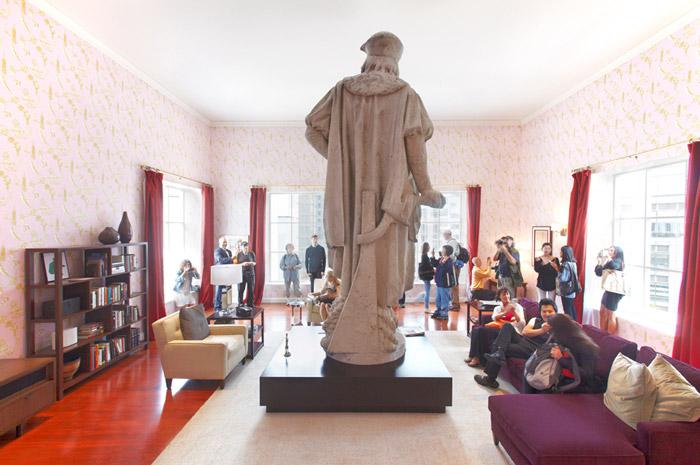If you have ever wondered how it might feel to look out over New York like the Christopher Columbus statue perched some 75 feet above Broadway on a tall granite column, now is your chance to find out. Until November 18, visitors to Tatzu Nishi’s installation Discovering Columbus can climb six flights of stairs to a living room constructed around the statue. Presented by the Public Art Fund, the title of the project suggests a reckoning of gazes, but the project itself seems to be more like Nishi’s interpretation of the American dream.
Despite the huge statue standing in the middle of the living room coffee table, the room is otherwise surprisingly ordinary. It is so normal that it looks like a condo-model showroom; there are couches, armchairs, bookshelves and even a working flat-screen TV. Visitors peruse the books, sit and chat or look out the windows at the spectacular views. The wallpaper, with its pink background and images in greenish khaki, is the one element of the installation that is not prefabricated. Nishi designed the pattern with images of 20th-century Americana: Mickey Mouse, Elvis, Michael Jackson, Marilyn Monroe, hot dogs, a Coke bottle and, of course, the McDonald’s golden arches—an image and product cluster that represents the global exports of US pop culture.
Nishi is best known for built environments that redefine a visitor’s interaction with a particular symbolic monument. In 2011, he created a hotel suite around the famous Merlion fountain in Singapore (a mythical creature, the merlion is often used as a national symbol of Singapore). And in 2002, he built a full hotel around a statue of Queen Victoria in Liverpool. In New York, with his first North American work, one wonders if he chose the Columbus monument to underscore the “discovery” of America—along with the contentious advent of Western expansionism—or whether his choice was more aesthetic in nature.
The work provides an engaging exercise in the perception of public space, notwithstanding the physical exertion needed to get to the installation. Yet no reference to the long-contested history of Columbus plays into the work. The sculpture becomes, in many ways, just another real-estate fixture. Though I visited the installation prior to Superstorm Sandy, reflecting on my experience in its wake has made the irony of Nishi’s installation seem somewhat trite. This global centre has turned out to be vulnerable after all, and the view from the top must look different now.









